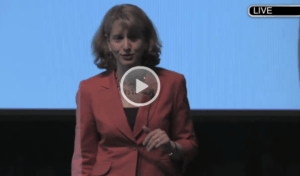Naomi Fried, PhD, is Boston Children’s Hospital’s chief innovation officer. This post is adapted from her opening keynote address this week at the Institute for Health Technology Transformation (iHT2) annual conference in Atlanta.
CLICK HERE TO WATCH THE KEYNOTE
Innovation is one of the most talked-about subjects in business and now health care. It is also one of the most misunderstood subjects. People confuse innovation with creativity, brainstorming and invention.
Simply put: Innovation is a process for testing and developing new ideas. Innovation in health care organizations does not happen by chance, and in fact follows a predictable course.
Several years ago I developed the idea of an innovation “lifecycle,” comprised of six predictable stages with a gap in the middle (more on that gap below). It’s a powerful paradigm for understanding and organizing innovation in a health care organization (or any organization, for that matter).
Stage 1: Initiate
An innovation’s lifecycle begins with the identification of a problem or opportunity. The innovator defines the vision and objectives, which should including identifying available resources and establishing the scope of the future project. Initiation is not typically a difficult stage, but it’s an important one to get right and, if skipped or not done fully, can cause problems later. Innovators may start with a grass roots problem, such as how to increase access to consults for newborns thought to have plagiocephaly, or flat head (a solution is now being piloted using digital photos). Or they may face a strategic challenge, such as the need for a better communication system for clinicians treating patients in the Emergency Department.
Stage 2: Ideate
Often innovators confuse ideation with innovation, but ideation is really a piece of the larger cycle. It involves sourcing, creating, evaluating and filtering ideas to meet the innovator’s vision. Brainstorming is one method, but I also encourage innovators to borrow ideas or seek inspiration from other industries, or even competitors. For example, a Boston Children’s Hospital nurse borrowed the idea of re-warming babies undergoing heart surgery (which requires cooling them to about 82 °F) with Mylar-lined hats – after seeing Mylar blankets used by Boston Marathon runners.
Stage 3: Pilot
After harvesting the best ideas, innovators must build and test a functional prototype of the new idea. We support the pilot stage at Boston Children’s with our Innovestment Grant and FastTrack Innovation in Technology programs. A new visualization scope to better intubate patients is an example of an innovation project currently in the pilot stage. To succeed in the pilot phase, innovators need to develop a clear set of metrics and avoid moving “goal posts.” Failures in the pilot stage are a form of success and an opportunity for learning.
The O-gap
Now comes a chasm. In an ideal world, new ideas would be easily and broadly adopted with little or no resistance. But in real life, people are often reluctant to embrace innovations. I have coined the term “operationalization gap” or “o-gap” to explain the challenge of diffusing a new idea broadly across an organization. O-gaps are common in large, siloed organizations, less common (or narrower) in smaller or hierarchical organizations.
Leadership support, additional funding, training, change management and communication can all help close the o-gap. Sometimes technical help is required to expand the number of end-users, as with the ALICE electronic whiteboard project for inpatient floors at Boston Children’s; its software prototype is being re-coded to make it robust enough for launch hospital-wide.
My best advice is to recognize the o-gap and plan for it. Engaging stakeholders early can make all the difference in disseminating an innovation.
Step 4: Operationalize
When a successful pilot is broadly implemented and the organization begins to realize the innovation’s full value, operationalization can begin. The MyPatients portal, which connects referring physicians to information about their patients while they’re at Boston Children’s, is now in this stage.
Step 5: Optimize
Many innovators treat operationalization as the last stage of an innovation. But it’s not. The innovation can be further improved and customized by end users. For example, our electronic medical record is being optimized as end users introduce their own small innovations. A parking innovation we operationalized last year is now being refined by the valets who park families’ cars.
Step 6: Obsolete or repeat
At some point, an innovation may no longer serve the user’s need. It can be hard to recognize when a solution has become obsolete; it could be due to changing needs, changing workflow or new technology available. It’s then time to retire the innovation and begin the lifecycle again.
Again, innovation doesn’t just happen — it follows a clear lifecycle that can be anticipated and planned for. Understanding and leveraging this lifecycle can help innovators be more effective – both individuals and organizations trying to develop meaningful programmatic support for innovation.
Where are you in the innovation lifecycle?








